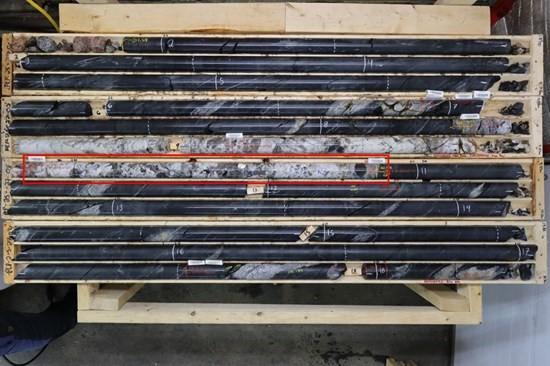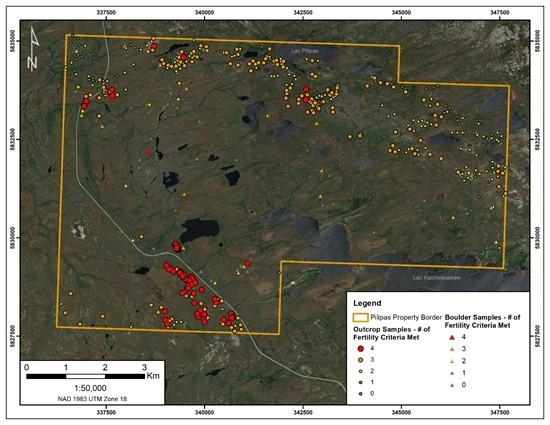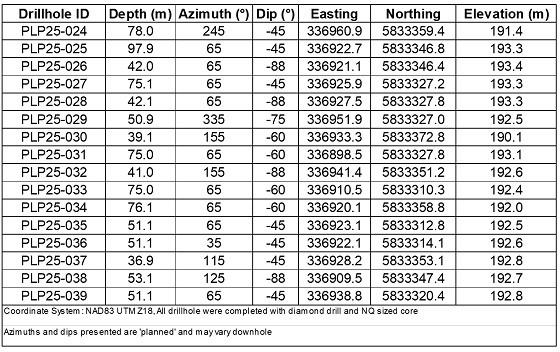
Ophir Expands High-Grade Cesium Zone at Depth with 0.92% Cs2O over 1.0 m at the HW3 Pegmatite, Pilipas Property, Quebec

Ophir Metals Corp. (TSX-V: OPHR) (OTCQB: OPHRF) (FSE: 80M) is pleased to announce assay results for 16 drillholes from the 2025 drill program on the Pilipas Lithium Property, located in the Eeyou Istchee James Bay region, Quebec. The Project is located proximal to existing hydroelectric power that flanks the Property to the east, and an all-season road that crosses the western side of the Property.
“Drilling at HW3 has confirmed cesium mineralization grading nearly 1% over one meter in the subsurface. Combined with the ~11 m by 4 m zone of elevated cesium values returned from surficial channel sampling at HW3 (See news release dated February 3, 2025), and the lithium-bearing pegmatite identified at HW1 that returned 53.2 m at 1.22% Li2O from drilling in 2024 (See news release dated December 11, 2024), these results highlight the strong multi-commodity potential at Pilipas. Few pegmatite fields worldwide demonstrate both cesium and lithium mineralization, and we believe this provides a strong foundation for follow-up exploration,” comments Shawn Westcott, CEO of Ophir.
Highlights:
- 2.5 m at 0.41% Cs2O, including 1.0 m at 0.92% Cs2O from drillhole PLP25-027
- 0.5 m at 0.26% Cs2O within pegmatite interval in drillhole PLP25-028
- 1.5 m at 0.46% Cs2O and 1.4 m at 0.21% Cs2O within basalt samples on margin of pegmatite dykes from drillhole PLP25-025 and PLP25-037, respectively
- Four samples returned >500 ppm Ta₂O₅, including a peak of 1,248 ppm Ta₂O₅ over 0.5 m, from within larger interval of 375 ppm Ta2O5 over 3.8 m in drillhole PLP25-032
The 2025 drill program concluded in mid-June with the completion of 16 drill holes totaling 936 m at the HW3 Cesium Pegmatite (Table 2). The analytical results reported herein represent all drill holes completed as part of the exploration program. Drillholes were planned on a tight grid spacing targeting the surface expression at depth and along strike.
Drilling in 2025 confirmed that the HW3 Pegmatites are present to moderate depth and capable of hosting strong cesium mineralization, as demonstrated by the intercept of 0.92% Cs₂O over 1.0 m (Figure 1). The cesium enrichment is not limited to a single intercept, with sixteen separate samples from 2025 drillholes returning values >0.06% Cs₂O. Intervals such as 0.26% Cs₂O over 0.5 m and 0.21% Cs₂O over 1.42 m demonstrate that the system is highly anomalous in cesium mineralization across multiple horizons.
Strongly anomalous to high-grade tantalum results were also returned from the pegmatites at HW3, with thirty-one (31) samples returning >50 ppm Ta2O5, the highest of which returned 1,248 ppm Ta₂O₅ over 0.5 m (Table 1). Additional intervals of 328 ppm Ta2O5 over 4.0 m and 375 ppm Ta2O5 over 3.8 m were returned from drillholes PLP25-037 and PLP25-032, respectively. These results highlight the multi-commodity potential of the system, extending beyond cesium and lithium.
Although pollucite in drill core has yet to be confirmed by X-ray diffraction (XRD), visual logging noted minerals consistent with pollucite in one interval of PLP25-027 (Figure 1), coincident with elevated cesium grades. This zone is consistent with the pollucite-bearing material confirmed by XRD in 2024 surface channel samples from the same outcrop area, supporting continuity of cesium mineralization from surface into the subsurface. Pollucite, the principal mineralized material cesium, is globally rare, and its occurrence at HW3 is significant. The 2025 drill program results demonstrate that the pegmatites at Pilipas are highly fractionated, consistent with the processes that concentrate cesium, lithium, and tantalum. Much of the 4.2 km corridor between HW1 and HW3 showings has limited outcrop exposure, providing scope for additional discoveries along the pegmatite trend.
Additionally, other areas of the Pilipas Property remain highly prospective for hosting Lithium-Cesium-Tantalum (“LCT”) mineralization for follow-up work, as indicated by strong geochemical fertility ratios obtained in pegmatite grab samples collected in 2024 (See news release dated May 21, 2025). The geochemical ratios of K/Rb, Nb/Ta, Zr/Hf, and Mg/Li are commonly used to assess the potential for pegmatites to host LCT mineralization. Fertile pegmatites (and their source melts) typically have ratios of K/Rb < 150, Nb/Ta < 5, Zr/Hf < 18, and Mg/Li < 10. The more of these indices that are met, the higher the likelihood that a given pegmatite could host LCT mineralization (See Figure 2).

Figure 1: Pegmatite in drillhole PLP25-027 which returned 1.0 m at 0.92% Cs2O (red box)

Figure 2: Fertility Criteria met by 2024 Surface Pegmatite and Intrusive Grab Samples
Table 1: Summary of Analytical Results of 2025 Pilipas Drill Program

Table 2: 2025 Drillhole Locations and Attributes

Quality Assurance / Quality Control
Drill core was saw-cut with half-core sent for geochemical analysis and half-core remaining in the box onsite. All core samples were securely transported by field staff to SGS Canada’s laboratory in Radisson, QC for standard sample preparation (code PRP90) which includes drying at 105°C, crush to 90% passing 2 mm, riffle split 250 g and pulverize 85% passing 75 microns. The pulps were then shipped to SGS Canada’s laboratory in Burnaby, BC where they were subsequently analyzed for multi-element (including Li, Cs and Ta) using sodium peroxide fusion with ICP-AES/MS finish (code GE_ICM91A50). Gold analysis was performed using Au by fire assay (Code GE_FAA30V5). A Quality Assurance/Quality Control protocol was incorporated into the program and included the insertion of certified reference materials and silica blanks at a rate of approximately 5% and 5%, respectively. Additional analysis of pulp-split and reject-split sample duplicates was also completed at a rate of approximately 5% to assess analytical precision at different stages. SGS Canada is independent of the Company.
Qualified Person
The technical content of this news release has been reviewed and approved by Kaylyn Niemetz, P.Geo., Geologist for Dahrouge Geological Consulting Ltd., a member in good standing of the Ordre des géologues du Québec (OGQ; permit no. 2418) and a Qualified Person under NI 43-101 Standards of Disclosure for Mineral Projects.
Ms. Niemetz has verified all scientific and technical data disclosed in this news release including the sampling and QA/QC results, and certified analytical data underlying the technical information disclosed. Ms. Niemetz verified the data disclosed (or underlying the information disclosed) in this news release by reviewing the assay data; and checking the performance of blank samples and certified reference materials. Ms. Niemetz detected no significant QA/QC issues during review of the data and noted no errors or omissions during the data verification process. The Company and Ms. Niemetz do not recognize any factors of sampling that could materially affect the accuracy or reliability of the data disclosed in this news release.
About the Pilipas Lithium Project
In December 2023, the Company entered into an option agreement with Azimut Exploration Inc (TSX-V: AZM) (OTCQX: AZMTF) to earn 70% interest in the Pilipas Property consisting of 135 claims totaling 7,100 ha situated within the La Grande Subprovince (Archean Superior Province). It is primarily underlain by volcano-sedimentary rocks (Greenstone) of the Lower Eastmain Greenstone Belt: conglomerate, sandstone, basalts and felsic to intermediate tuffs. Two regional NW-SE dextral faults transect the southwestern and northeastern parts of the Property.
About the Company
Ophir Metals Corp. is a diversified mineral exploration company focused on the exploration and development of the Pilipas Lithium Property in James Bay, Quebec, and the past-producing Breccia gold property located in Lemhi County, Idaho.
Ophir holds an option to earn a 70% interest in the Pilipas property over a three-year period from Azimut Exploration Inc. and an option to earn a 100-per-cent interest in the Breccia property.
MORE or "UNCATEGORIZED"
Kuya Silver Confirms High-Grade Silver-Gold Vein Mineralization at Umm-Hadid with Initial Drill Results up to 1483.9 g/t AgEq over 2 Metres
Kuya Silver Corporation (CSE: KUYA) (OTCQB: KUYAF) (FSE: 6MR1) is... READ MORE
First Phosphate Closes Final Tranche of Oversubscribed Private Placement
First Phosphate Corp. (CSE: PHOS) (OTCQX: FRSPF) (FSE: KD0) is... READ MORE
GFG Receives Final Payment from the Sale of its Rattlesnake Hills Gold Project
GFG Resources Inc. (TSX-V: GFG) (OTCQB: GFGSF) announces that i... READ MORE
Goliath Receives $1,730,882 Through Warrant Exercises, Inclusive Of Crescat Capital A Longtime Strategic And Cornerstone Shareholder
Goliath Resources Limited (TSX-V: GOT) (OTCQB: GOTRF) (FSE: B4IF)... READ MORE
Robex Pours First Gold at Kiniéro on Schedule and Budget
Highlights: Gold bar weighing 2.64 kilograms (85 oz) poured in th... READ MORE












